Car body configurations
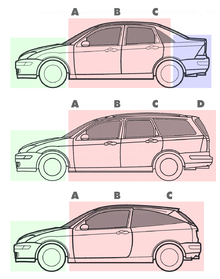
The configuration of a car body is typically determined by the layout of the engine, passenger and luggage volumes. These three volumes can be shared or separate volumes. Often when they are separated, the boundaries are the A-pillar, B-pillar or C-pillar.
Common car body configurations are one-box (eg a van), two-box (eg a hatchback) and three-box (eg a sedan) designs.
One-box design
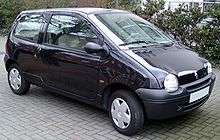
A one-box design — also called a monospace, mono-box or monovolume configuration[1] — gives the impression of a car being a single volume combining engine, cabin and cargo areas. This is achieved is a design that pulls the base of a vehicle's A-pillars forward, creating an impression of spaciousness.[1][2]
Most light commercial vehicles and minivans are one-box designs. Passenger cars with a one-box design include the Renault Espace, 1992 Renault Twingo I, Tata Nano and 1997-2004 Mercedes-Benz A-Class.
Two-box design
Two-box designs articulate a volume for engine and a volume that combines passenger and cargo volumes, e.g., station wagons or (three or five-door) hatchbacks, and minivans like the Chrysler minivan.[1][2]
Three-box design
Three-box design is a broad automotive styling term describing a coupé, sedan, notchback or hatchback where—when viewed in profile—principal volumes are articulated into three separate compartments or boxes: engine, passenger and cargo.[1]
Three-box designs are highly variable. The Renault Dauphine is a three-box that carries its engine in the rear and its cargo up front. The styling of the Škoda Octavia integrates a hatchback with the articulation of a three-box. This style was later used by its larger Škoda Superb, which marketed as the TwinDoor, within the liftgate operable as a trunk lid or as a full hatchback. As with the third generation European Ford Escort (also a hatchback), the third box may be vestigial. And three-box styling need not be boxy: Car Design News calls the fluid and rounded Fiat Linea a three-box design[3]—and most examples of the markedly bulbous styling of the ponton genre are three-box designs.
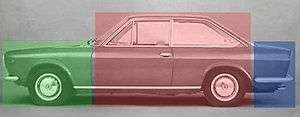
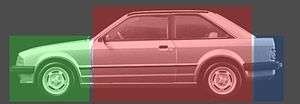 A three-box hatchback, the European Ford Escort
A three-box hatchback, the European Ford Escort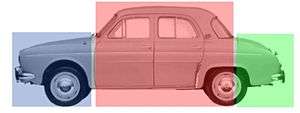 A three-box sedan, the Renault Dauphine
A three-box sedan, the Renault Dauphine
See also
References
- 1 2 3 4 "Starting Out: Car Design Glossary - Part 2 pg 3". www.cardesignnews.com. Retrieved 31 May 2018.
- 1 2 Mike Mueller (2003). American Cars of the '50s. Crestline Imprints. ISBN 0-7603-1712-7.
- ↑ "Fiat Linea". Car Design News.